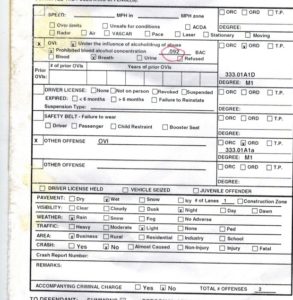WHAT IS MUNICIPAL CODE SECTION 333.01(A)1(A)?
Section 333.01 is the local municipal code section for OVI (operating a vehicle under the influence). If you received a ticket with “333.01A1a” written on it, it means you have been charged with an OVI likely in a Mayor’s Court.
In many smaller townships in Ohio, the local municipal code section for OVI is Section 333.01.

Local Municipal OVI – Section 333.01(A)(1)(a)
.
Municipalities in Central Ohio that use 333.01(A) as their OVI law include:
Delaware OVI Code
Hilliard OVI Code
New Albany OVI Code
Westerville OVI Code
Whitehall OVI Code
Worthington OVI Code
Section 333.01 in each of these municipal codes defines the general definition of Operating a Vehicle Under the Influence of Alcohol or Drugs. (Often shortened to OVI in Ohio).
What Does Code Section 333.01(A)(1)(A) Say?
The statute is broadly worded and is a “catch all” for all impaired driving situations. The law states that no one may operate any vehicle while under the influence of a controlled substance (drugs) or alcohol, or any combination of the two.
Section 333.01(A)(1)(a) OVI’s closely mirrors the language contained in the Ohio Revised Code 4511.19(A)(1)(a).
POTENTIAL PENALTIES ASSOCIATED WITH
CODE SECTION 333.01(A)(1)(A)
If you have been charged with an OVI under Section 333.01(A)(1)(a), the potential penalties include:
-
A mandatory jail term: 3 days to 6 months. This time can be served in an intervention program in some cases.
-
A fine: From $375.00 to $1,075.
-
A license suspension: From 6 months to 3 years. (A driver may be eligible for driving privileges during this suspension.)
DEFENSES TO OVI UNDER CODE SECTION 333.01(A)(1)(A)
There are several defenses that may be available to a driver charged with an OVI case under Section 333.01(A)(1)(a).
These defenses include:
-
Probable Cause: A police officer will generally have probable cause to pull over a driver for even minor traffic infractions. Speeding and headlight violations will give an officer sufficient grounds to pull over a driver. However, in some instances, the facts do not support probable cause. In these instances, a lack of probable cause will result in the traffic violation, and the subsequent OVI charge to be thrown out.
-
Improper Testing: The Police must adhere to rigorous standards when conducting testing to determine whether one is under the influence. If an officer fails to adhere to those standards, it may lead to the OVI charge to be thrown out. Some examples of improper testing include the testing machine being improperly calibrated, the tests were administered outside the proper timeline, and the officer administering the tests did not follow the exact procedure.
-
Incorrect Charge Under the Statute: It is possible that the facts surrounding a driver’s case do not support a charge as written under the language of the statute. In these cases, someone may have his or her case dismissed because the facts of the case do not support a conviction of an OVI
-
Coercion: In some cases, a Defendant may have been pressured by police to provide a statement or submit to testing that ultimately shows the Defendant was under the influence of alcohol or drugs while operating a vehicle. A Defendant is entitled to certain constitutional protections against police coercion that would disqualify any coerced statement or test.
Alcohol related offenses vary from case to case and there can be difficulty understanding what defenses may be available to you.
It is important to contact an attorney who is knowledgeable about all possible defenses available to you under Section 333.01(A)(1)(a).
If you have questions about your mayor’s court OVI and related charges, talk to our Section 333.01(A)(1)(a) mayor’s court OVI attorneys at 614-361-2804.


